Introduction: Why Is Postcolonialism Art Important?
As humans, we are able to identify ourselves as persons. However, there is also the language, theculture, the mentality embedded in ourconsciousness, and thus we perceive the concept of “I”within the framework of a much more extensive and complicated concept, which is the “nation.”Postcolonial studies, which are the matter of our current interest, are the science’s attempt toexplore national identity in the postcolonial world and how humans perceive it.
The term “postcolonialism” implies the cessation of the Mother Country’s predominance over thecolonized ones and the historical period after the colonization. In art, postcolonialism isusuallydescribed as a form antagonistic to colonialism. Anita Seppä (2010) interprets the term as ahistorical consequence of the colonized peoples’ negative experiences (para. 43).
Post-colonial art is a modern phenomenon. Being short, its history is very eventful. Famous artistsand photographers from India, Australia, the Philippines, and the US reveal this theme in theirworks. What is Postcolonialism art and why is it important? This essay answers the questions byfocusing on the examples of paintings by Jean-Michel Basquiat and Gordon Bennett.
Postcolonialism seeks to disrupt the power of the colonists and turn their violence back unto them. There is an idea that postcolonialism is used detrimentally as a means of resetting the world into a binary model: pre- and postcolonial (McClintock, 1995, p. 11). Seppä confronts this idea by asserting that postcolonial art depicts the glory of the Western history in an inverted fashion of violence and brutality. Finally, postcolonial art, in addition to being by nature hybridist – that is, incorporating the opposite cultures and integrating them into a whole, – makes a mockery of the opposing culture. It does so by using visual power and making it look somewhat underdone (Seppä, 2010, para. 44).
Thus, the postcolonial art represents the lost self in the world were the colonies are gone but the colonialist mind still lingers. It is focused around the multidimensional, amalgam model of the world and the search which is plagued by the perception of the unified rooting of all humans. One of the artists whose works are perforated with constant search and are a unique example of postcolonial art was Jean-Michel Basquiat.
Jean-Michel Basquiat had Haitian to Puerto-Rican to African to AfricanAmerican heritage and was aware of it. He began as a spray painter vandalizing the state property with enigmatic and clever aphorisms; at the age of twenty, he exhibited his artwork publicly (Parker, 2012, p. 56). His African American identity was emphasized by his reviewers to create an image familiar and recognizable in white society.
However, in his masterpieces as well as in his public appearances, Basquiat eternalized the image himself. He acted in a triangular set of patterns: he was simultaneously a victim of violence, a force of power in flesh, and an entity rebellious against the binary world. He even thought of himself as an incarnation of African deities (Okpewho, Davies, and Mazrui, 2011, p. 439). As for the art, Basquiat’s self-assigned celestial nature can be traced as one of the most powerful motifs. Another one was the artist’s perception of the world as a hybrid, a culture galore where his self got inevitably lost.
He was only too well aware how multisided and versatile cultural experience could be. The hybridity of the world, in his perception, consisted in the culture paradigm shift. He was an African American in the US, and this made him reconsider whether the national identity was at all stable. He came to a conclusion that it was not and these concerns are visible in his works. A plethora of identities within one human mind could not allow for a binary model of the world especially since he had known that, on the inside, humans were all alike (Dimitriadisand McCarthy, 2001, p. 95).
Thus, Basquiat did not comply the colonialist collective subconscious and made masterful attempts at using the colonist ideas against the latent colonizers. His work represents the search of an identity and the multifaceted perception of the world, which are the attributes of postcolonial art and history.
Gordon Bennett was raised oblivious to his Aboriginal roots. However, working at Telecom, he had to face racism in everyday, routine form, and he decided to find his identity. His artwork was an indispensable part of the search (Heiser, 2000, para. 1). Jean-Michel Basquiat as an artist inspired him since the latter had not lived to meet Bennett personally. Gordon Bennett recognized the struggle for identity as something beyond the boundaries of history and cultural context; it was a point both artists shared. He also appreciated Basquiat’s style and thought he understood the causes of Basquiat’s drug issues that led to the untimely death (Gordon Bennett, para. 10).
As to the postcolonialism in Gordon Bennett’s artwork, it addresses the issues of the lost identity and the fracture of the world into multiple cultures – and the binarity of it, at the same time. He feels the terrible historical mistakes and reproduces them on his canvases. His works lack Basquiat’s mimetic mockery of the binary world, instead appearing somewhat didactic. Nevertheless, the artist embodies the ideas of the likeness of all humans as he tries to seek an unused and non-banal way to voice his concerns over political and social issues in the form of postcolonial imagery. (Heiser, 2000, para. 3).
Post-Colonial Art: Jean-Michel Basquiat’s Works
Jean-Michael Basquiat was one of the most creative artists who knew how to depict the world around him in his artworks. According to Dimitriadis and McCarthy (2001), some of the art dealers considered him primitive partly because of the simplicity of his work, but primarily because of his skin color (p. 23). However, his works brought out post-colonialism in its truest form, and to him the victims of social injustices were indeed the heroes and saints of the society because of their unique ability to endure suffering.
Seppä (2010) says that Basquiat’s work were full of mimetic mockery of our binary world, always embodying the ideas of likeness of all humans irrespective of the different in skin color or any demographical factors (p. 3). He uses imagery to champion for the rights of people who have always suffered at the hands of the rulers in the society. He knew that he was never taken seriously by the art dealers because of his skin color. In the figure below, he tries to explain what it would take for him to get the acceptance among the society of artists in the country, most of whom were Whites
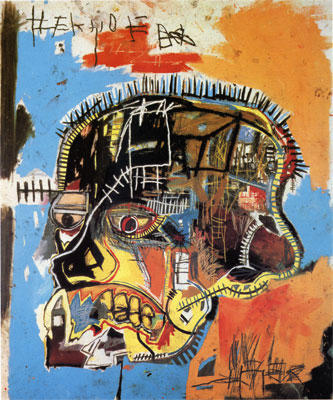
To him, the only way he would have been accepted by this White-dominated society was to be skinned alive and bleached of the blackness so that he would become a White. In this painting, he demonstrates the process of being skinned, and the black pigments being eliminated. His message was simple and very clear, that it was almost impossible for him to be taken seriously in this society where African Americans were considered second class citizens. The color of the skin of African American was like a curse in a post-colonial America where race closely defined one’s social status. Character, academic qualifications, and all other good attributes were inferior to one’s race when it came to gaining acceptance in the society.
According to Seppä, Basquiat admired African Americans who were able to achieve success in various fields such as sports and art (p. 3). To him, these were people to be celebrated because of their ability to succeed in a suppressive environment where the Blacks were not free in a post-colonial America.
The colonialism in the country had been brought to an end, but colonialists’ melancholic attachment could not allow them to accept a new social order where everyone in the society had to be given equal opportunity. In what Basquiat considers post-colonialism, the African Americans could not enjoy the fruits of freedom, like their Whites. That is why to him any small achievement of African Americans had to be celebrated because of the effort they had to put in their work. The figure below is one of the popular paintings of Basquiat of a boxing champion.
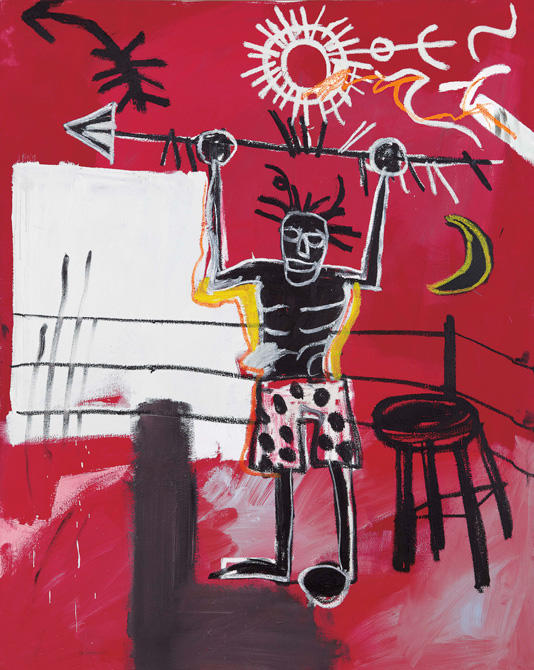
Basquiat personalized most of his paintings. He had dreadlocks, and the heroes in most of his artworks also had a similar hairstyle. In this particular painting, he depicts an African American boxing a champion who has just won a match in a ring. He believed that one day African American will achieve the kind of success they had in the boxing ring in the socio-economic and political environments in the country. The progress towards that kind of freedom was slow and painful, but just like a boxer, joy shall come at the end of it all (McClintock, 1995, p. 12).
One of the intrigues that Basquiat depicted in his work was the irony of the African American police. According to Basquiat, Warsh, and Davvetas (1993), the police was the tool used by the post-colonial Whites in America to ensure that Blacks remained second class citizens with very limited rights (p. 83). Most of the officers were deployed in Black neighborhoods to ensure that they observed the discriminatory laws at all times. They were under instruction from their masters to use physical force as a way of enforcing the law. The following figure shows a Black police officer in full combat, ready to enforce the White man’s laws

The irony of an African American policeman was that he had to make his own people suffer. He was always used as an instrument through which the Whites achieved superiority in a country where everyone should enjoy the freedom of independence. It was rare to find police officers in combat gear patrolling the White neighborhoods unless they had been specifically summoned to address a given problem (Yaszek, 2006, p. 51). However, the Black neighborhoods were like police states, where every corner of the streets was constantly patrolled by the men in uniform. Such Negro policemen had to brutalize their brothers, fathers, sons, friends, and close family members simply because they had to obey the command of their superior.
Basquiat was greatly saddened by the death of one of his colleagues who was shot dead by the police officers during a riot. In the painting below, he depicted himself in a coffin, saying that there was a possibility it would have been him in his friend’s coffin.
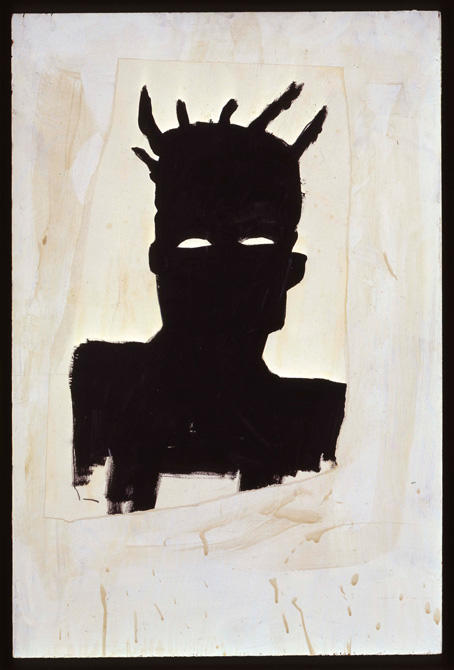
He lamented that Black life in post-colonial America did not matter. His death meant very little to the ruling class. In this painting, he tries to bring out the idea that his death may not mean much to these who took power from the colonial masters. It will be just another Negro eliminated from the streets of Chicago.
Postcolonial Art: Gordon Bennett’s Works
Gordon Bennett, like Jean-Michel Basquiat, used his artistic skilled to bring out the post-colonialism in Australia and how one community benefited at the expense of others. His Aboriginal heritage made him experience the suffering of this community at the hands of the White settlers. At work, in his neighborhood, and in major social gatherings, Bennett had to endure derogatory remarks and racism from his peers and people from whom he expected love and respect. He was displeased by the plight of the aboriginal and people of color in post-colonial Australia. He lamented that these people were denied their basic rights, and most often considered outsiders in a society that was dominated by the Whites. In the painting below, he depicts a chronological path taken by the migrants to displace and dismiss the natives from their own land.
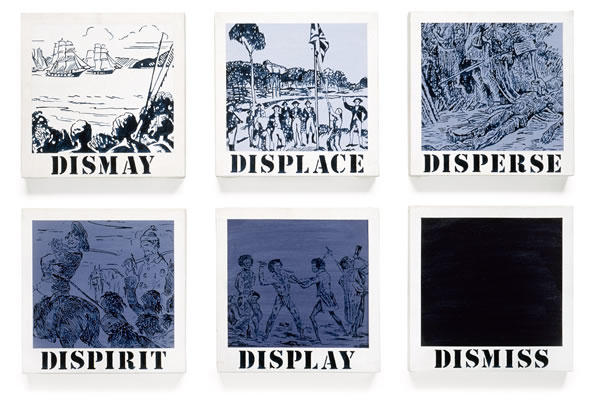
The entry of the White settlers into Australia came with dismay. At first, they came as people keen to spread the gospel and transform the locals. However, this turned out to be a scheme to displace the Aboriginals. After their entry, they displaced the natives from the prime lands and dispersed them to the drier parts of the country. They were dispirited then displayed by the settlers to gain independence from the rule by the Queen of England. The aboriginals believed that they would benefit from the freedom of their country. However, this was not to be as they were soon dismissed by the settlers and considered outsiders in their own country. In the post-colonial Australia, the aboriginals never really gained independence. They became subjects to the Whites and were denied opportunity to develop in their own land.
Bennett drawings and paintings brought out post colonialism in Australia very clearly, especially the sufferings of the Aboriginals in the hands of the White settlers. In the figure below, he painted a migrant who has come to Australia and gained power, freedom, and success that is unmatched by the locals. In this painting, the migrant is independent and contented with life.
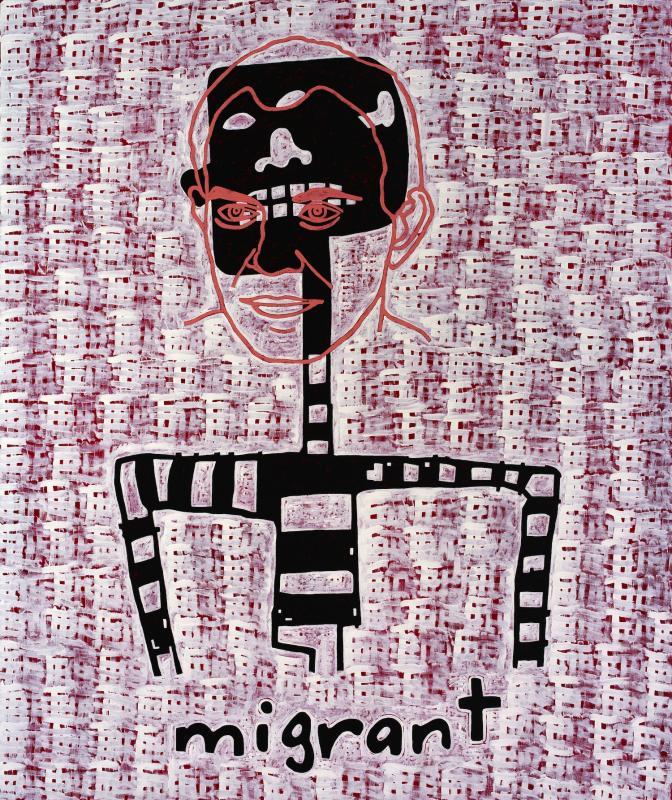
The freedom, contentment, and success of the migrant sharply contradict the pain, suffering, and disillusionment of the natives, the aboriginals. Their land was taken, their interests ignored, and rights abused by the migrant majorities. They had to struggle in post-colonial Australian because their means of production had been taken from them. The figure below shows a disillusioned native struggling with life in his own home country.
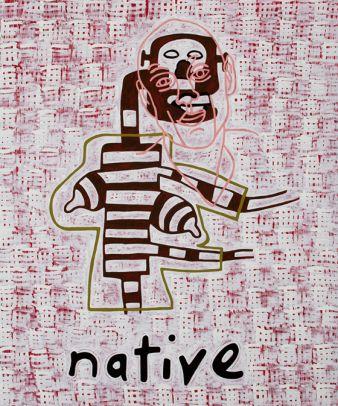
The natives were turned into peasants in post-colonial Australia as they had to work for the migrants to earn a leaving. Bennett finds it ironical that the natives would sometimes be assigned the role of protecting properties robbed from them by the Whites, as depicted in the figure below.
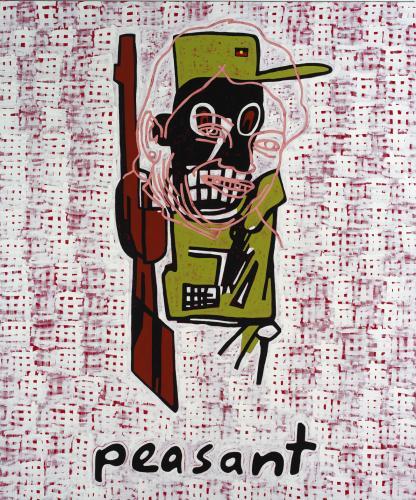
This sad state of affairs in the country was complicated by the withdrawn nature of the aboriginals. They withdrew to remote parts of the country to live in peace and quiet, away from the struggles in the major cities. To the migrants, this withdrawal offered them opportunity to justify their stay in the country. Bennett believed that city dwellers, who were predominantly Whites, had better opportunity to achieve socio-economic and political success (Okpewho, Davies, and Mazrui, 2011, p. 43). They were independent thinkers who were keen to explore new things in life. Their independent nature is depicted in the figure below.
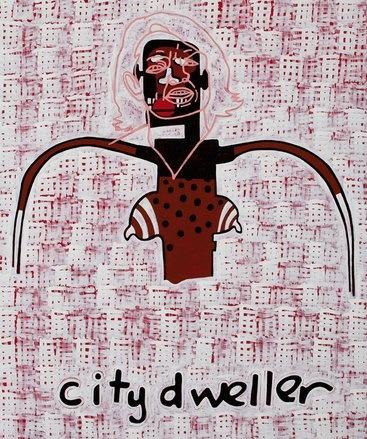
Conclusion: Postcolonialism in Contemporary Art
The notion of post-colonialism has been depicted in our identity as human beings. During colonial era, many people across the world blamed the colonial masters of being oppressive and discriminative in defining the social structure. In post-colonial era, issues such as segregation, racism, and all the practices that unfairly benefited one group at the expense of another were expected to come to an end.
However, this was not to be in many parts of the world. Racism in the United States and Australia, just like in many other parts of the world, became stronger in post-colonial era. The artworks of Jean-Michel Basquiat and Gordon Bennett bring out the concept of colonialism and how it affected the society. Basquiat gives a clear picture of the sufferings and pain the African Americans went through living in post-colonial America. Bennett also brings out the neglect and torture that the aboriginals in Australia are subject to in their ancestral land.
References
Basquiat, Jean, Larry Warsh, and Demosthenes Davvetas. Jean-michel Basquiat: The Notebooks. New York: Art + Knowledge, 1993. Web.
Dimitriadis, Greg, and Cameron McCarthy. Reading and Teaching the Postcolonial: From Baldwin to Basquiat and Beyond. New York, New York: Teachers College Press, 2001. Web.
“Gordon Bennett.” Visual Arts. Web.
Heiser, Jorg. “Gordon Bennett.” Frieze Magazine 51 (2000). Web.
McClintock, Anne. Imperial Leather: Race, Gender, and Sexuality in the Colonial Contest. New York, New York: Routledge, 1995. Web.
Okpewho, Isidore, Carole Boyce Davies, and Ali A. Mazrui. The African Diaspora: African Origins and New World Identities. Bloomington, Indiana: Indiana University Press, 2011. Web.
Parker, Kimberley. “Basquiat, Jean-Michel.” Postcolonial Studies. Web.
Seppä, Anita. “Globalisation and the arts: the rise of new democracy, or just another pretty suit for the old emperor?” Journal of Aesthetics & Culture 2 (2010). Web.
Yaszek Lisa. “Afro futurism, Science Fiction, and the History of the Future.” In Socialism and Democracy 20, no. 3 (2006): 41-60. Web.
